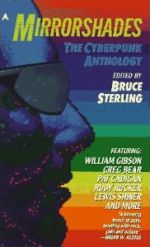Clothes Make the Man (or Woman):
Techwear and character in scifi
Sometimes Molly even wears an actual pair of sunglasses over her inset lenses, to hide her identity. But the fact that she can never actually take her own shades off symbolizes her inability to share her feelings and connect with other human beings. Ironically, with all her vision enhancements, it’s a blind ninja and a man who sells illusions who finally manage to best her. When an antagonist shatters one of Molly’s lenses, an accomplice remarks that they’ll finally “see what color her eyes are” (p.221). But even though Case actually gets to see directly through Molly’s eyes – experiencing things from her point of view while jacked into a live simstim feed – he never really truly sees her. He never does find out the color of her eyes. Nor does the reader, though we get occasional glimpses of her true colors from the bits of her past she confides to Case. Mostly, what we know about Molly is that she’s hiding something. And we know that from the first moment we see her in her shades, and you also know she’s not wearing them because her future looks bright. Her lenses aren’t rose-colored. They’re black.
In science fiction, where one’s attire can be so technologically advanced as to take on a life of its own, it’s easy to see how techwear plays a prominent role not just in establishing the scifi-ness of the setting, but in developing character, too. Whether it’s a complete suit of armor, a fancy pair of shades, or something else, what a character wears can tell us a lot about who they are.
You maybe shouldn’t judge a book by its cover, but sometimes clothes do make the man. Or woman. (Or unique nonhuman entity.)
Works Cited:
Gibson, William. Neuromancer. New York: Ace, 1984.
Gibson, William. “Johnny Mnemonic” in Omni (May 1981). Reprinted in Burning Chrome. New York: Arbor House, 1986.
Gross, Terry, interviewing Jeremy Renner On Fresh Air from WHYY (Feb. 24, 2010). See http://www.npr.org/templates/transcript/transcript.php?storyId=123966423
Heinlein, Robert A. Starship Troopers. New York: Putnam. 1959.
Steakley, John. Armor. New York: Daw, 1984.
Sterling, Bruce. “Preface” to Sterling,Bruce, ed. Mirrorshades: The Cyberpunk Anthology. 1986. See http://project.cyberpunk.ru/idb/mirrorshades_preface.html
About the Author: Henry Cribbs somehow managed to sneak his science-fiction poem about Schrödinger’s cat into the literary art journal Lake Effect, and has also published book reviews for Philosophical Psychology, Chicago Literary Review, and Black Warrior Review. He taught philosophy and creative writing at the University of South Carolina for several years, and now forces his high school English students to read Ray Bradbury. He currently serves on the editorial board for Nimrod International Journal of Prose and Poetry.
























3 comments
[…] This post was mentioned on Twitter by Jo Thomas, Michael Ray – Editor. Michael Ray – Editor said: "Clothes Make the Man (or Woman):Techwear and character in scifi" – an excellent essay by Henry Cribbs in Redstone SF #3. http://is.gd/e0AnG […]
[…] Clothes Make the Man (or Woman):Techwear and Character in SciFi by Henry […]
A quibble: Hideo isn’t blind when Molly gets captured–he isn’t blinded until later–and in fact they never fight at all. It’s really Riviera, the illusionist, who defeats her, as you mention.